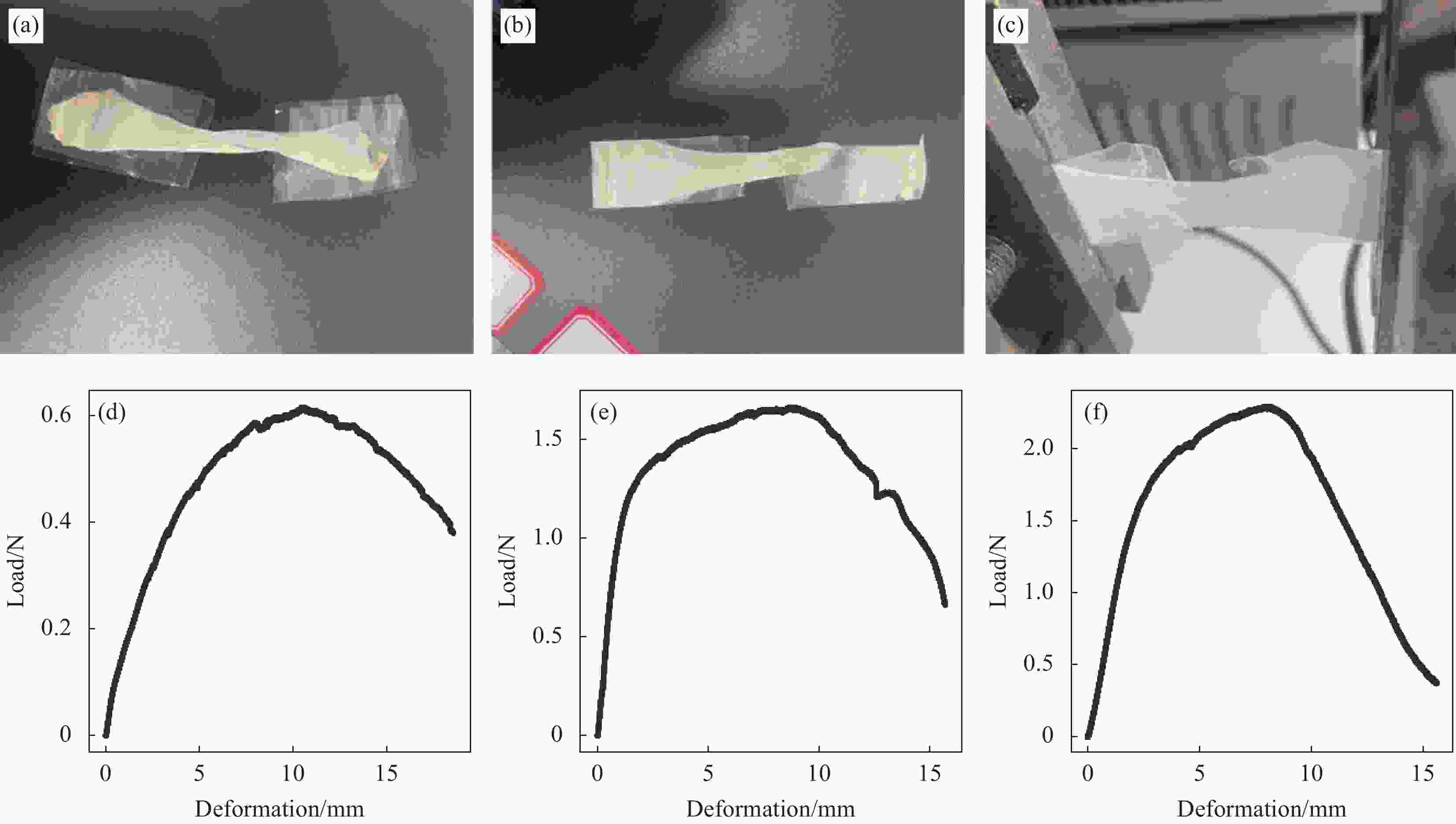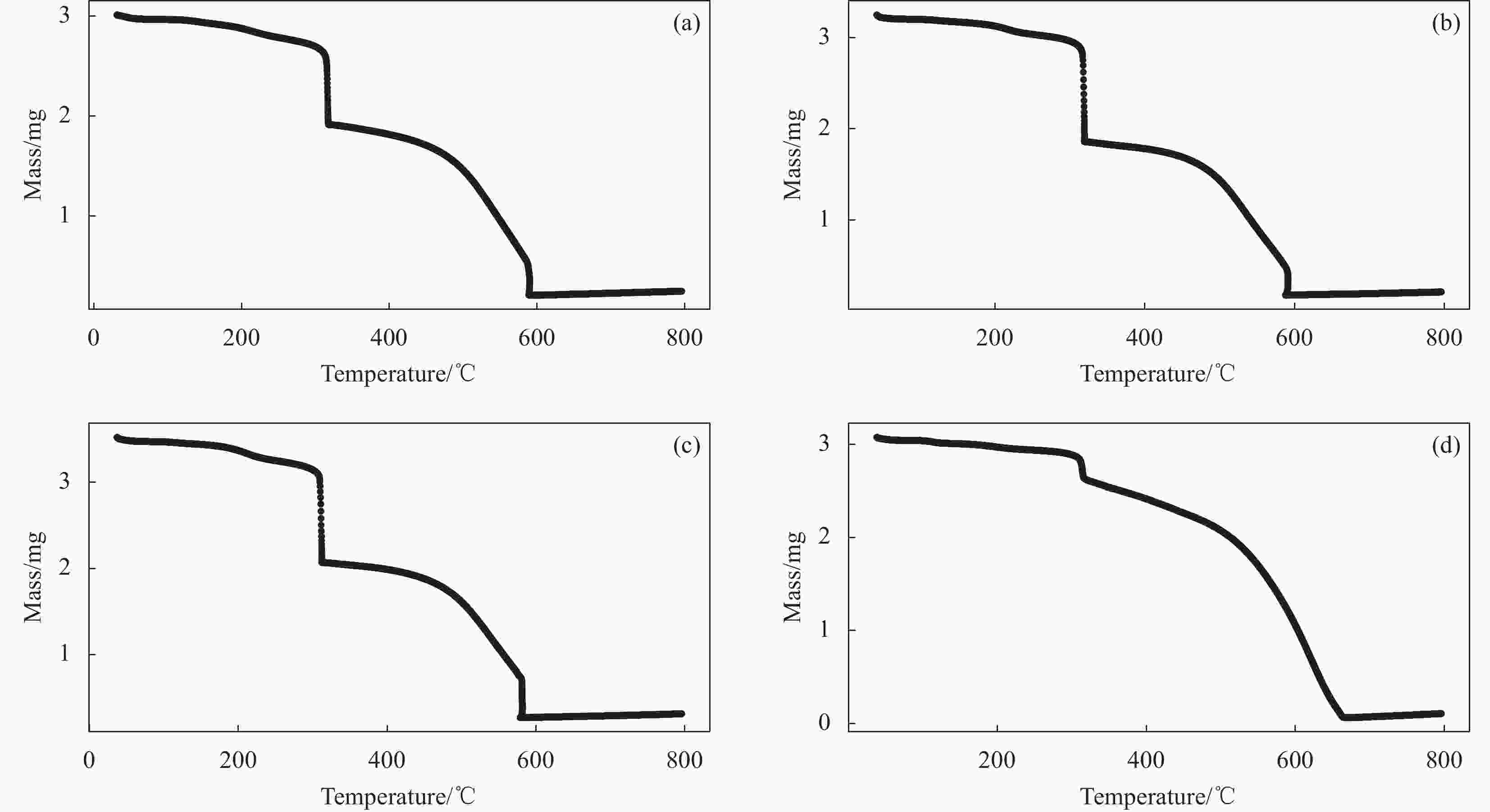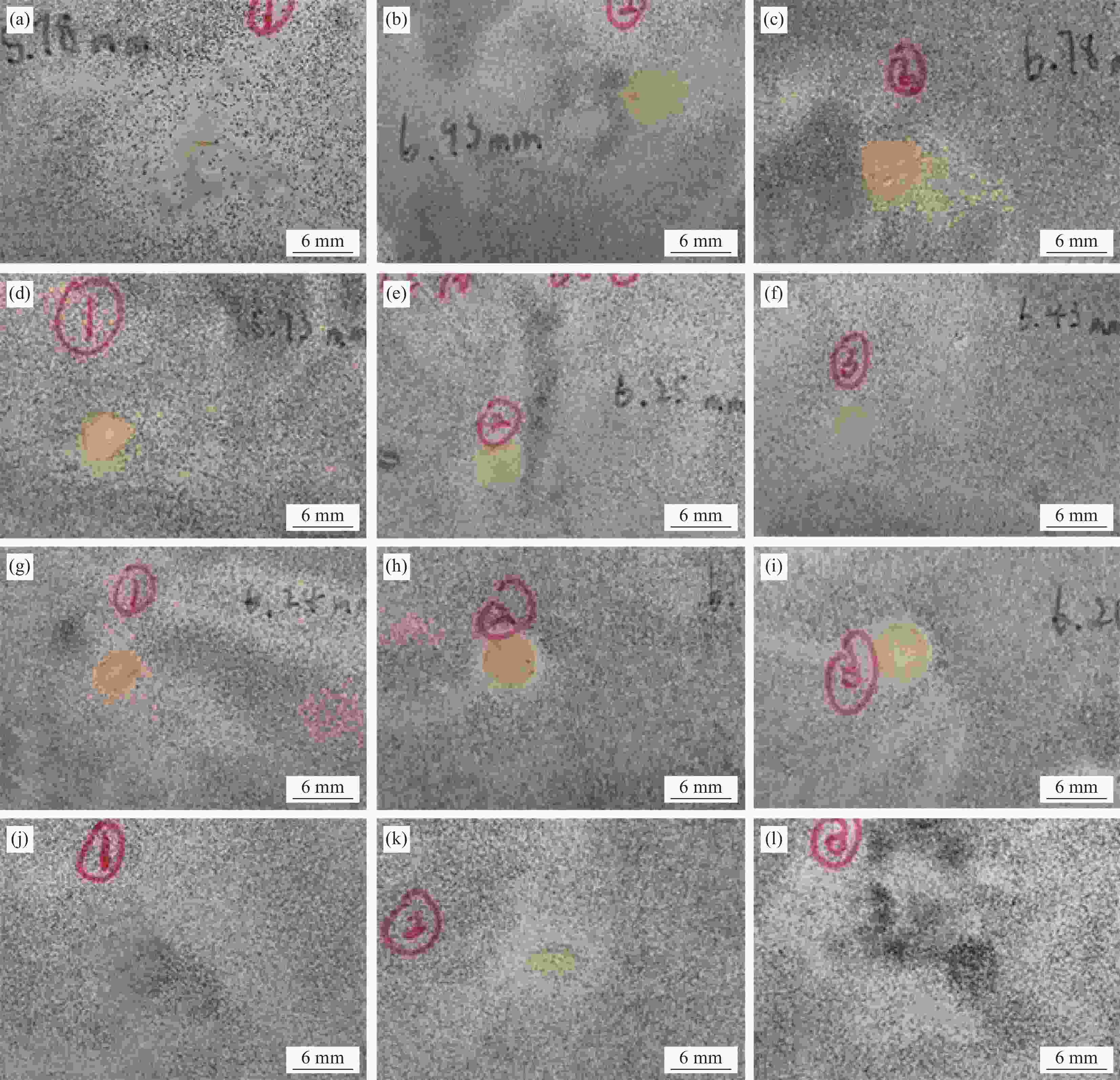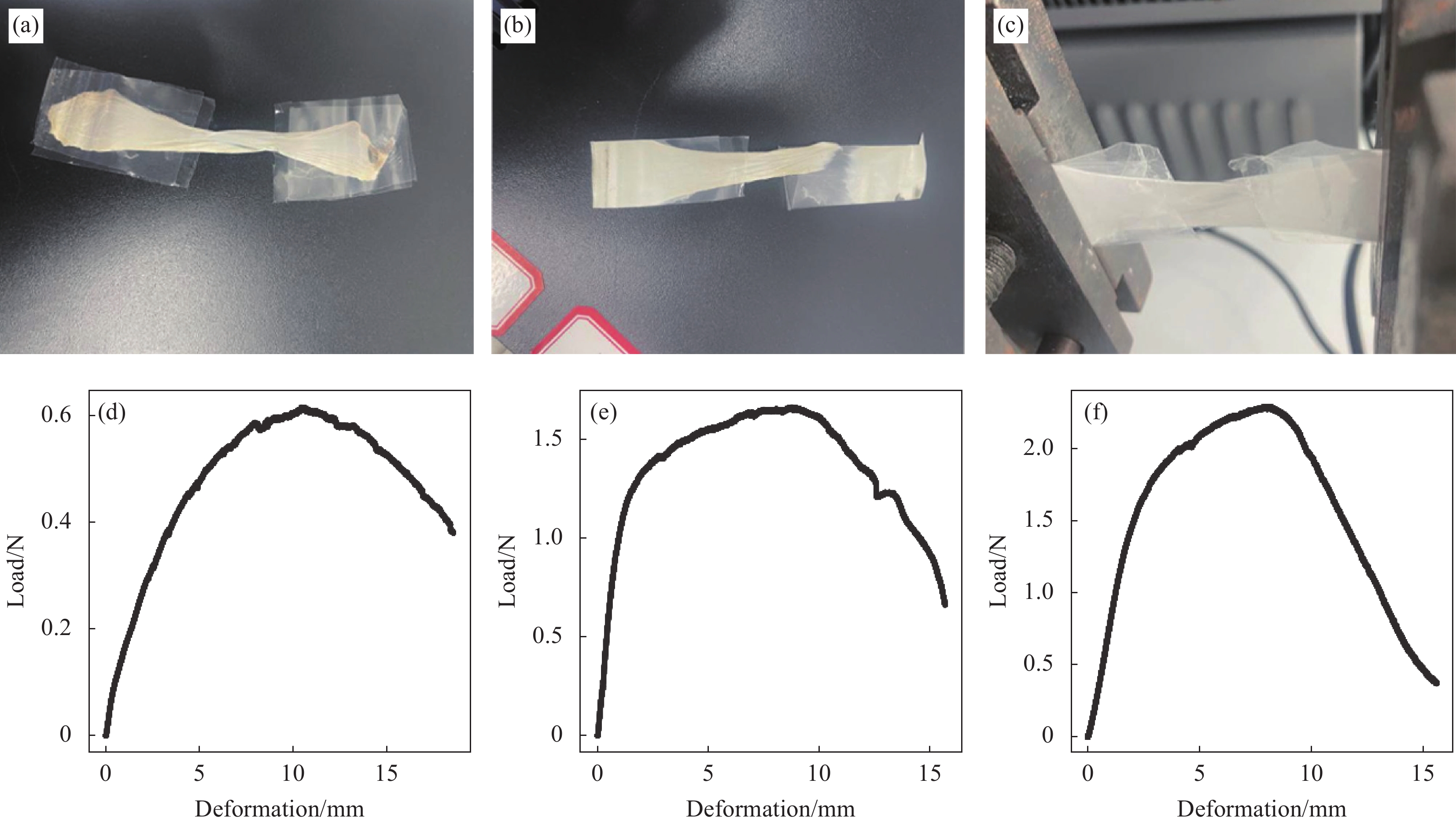Preparation of composite polyacrylonitrile - nano silver electrospun fiber membrane and its application in controlling microbial deterioration of grotto cultural heritage
-
摘要: 利用静电纺丝技术将抑菌活性成分与基体纤维进行复合,是制备新型抑菌材料的有效手段。为了制备新型石窟文物微生物病害防治材料,本文利用静电纺丝技术制备了聚丙烯腈(PAN)-纳米银(AgNPs)复合静电纺丝纤维膜,并评估了其抑菌效果。通过将一定量的PAN与N, N二甲基甲酰胺进行混合,加入硝酸银及茶多酚的方法制成带有银颗粒的纺丝原液,再利用静电纺丝技术制备了含银颗粒的纳米纤维膜。通过改变PAN的浓度和反应温度,调节电纺纤维膜的理化性质,筛选适用于防治石窟文物病害的电纺纤维膜的最优制备流程,并对其在实验室内和户外的抑菌效果分别进行了验证。结果显示:含12wt% PAN在80℃条件下制作的复合纤维膜同时兼具了纤维力学性能佳及银颗粒浓度高的优点,是筛选得到的PAN-AgNPs静电纺丝纳米纤维膜的最适制备条件;银复合纳米纤维材料对两种石窟文物退化相关微生物黑曲霉和青霉菌均具有抑菌作用,在户外岩石表面条件下也表现出了显著的抑菌效果。上述研究结果表明,本文制备的PAN-AgNPs复合静电纺丝纤维膜具有潜在的石窟文物微生物病害防治的应用价值。Abstract: Using electrospinning technology to compound antibacterial active ingredients with matrix fibers is seen as an effective means to develop new antibacterial materials. To develop new microbial deterioration control materials for grotto cultural heritage, composite polyacrylonitrile (PAN)-nano silver (AgNPs) electrospun fiber membrane was developed by electrospinning technology. The antibacterial effects of the fiber were further evaluated. Spinning stock solution containing silver particles was prepared by PAN mixing with dimethylformamide, adding silver nitrate and tea polyphenols. Then, the nano fiber membrane containing silver particles was prepared by electrostatic spinning technology. By changing the concentration and reaction temperature of PAN, the physical and chemical properties of electrospun fiber membrane, screening the optimal preparation process of electrospun fiber membrane suitable for the prevention and control of grotto cultural heritage microbial deterioration, the antibacterial effect of fibers was verified in the laboratory and outdoors respectively. The results show that the composite fiber membrane prepared with 12wt% PAN content at 80℃ has the advantages of good fiber mechanical properties and high concentration of silver particles, which is the optimal preparation condition of composite PAN-AgNPs electrospun fiber membrane screened in this study. Silver composite nanofiber material has antibacterial effect on Aspergillus niger and Penicillium ap., two microorganisms related to the deterioration of grotto cultural heritage. Significant antibacterial effect under outdoor rock surface conditions has been detected. These results indicate that the composite PAN-AgNPs electrospun fiber membrane prepared in this study has application value for the control of grotto cultural heritage deterioration.
-
图 1 纤维膜力学性能检验:(a) 12wt% 60℃复合纤维膜抗拉强度测试断裂走向;(b) 12wt% 80℃复合纤维膜抗拉强度测试断裂走向;(c) 12wt%纯PAN纤维膜抗拉强度测试断裂走向;(d) 12wt% 60℃复合纤维膜抗拉强度测试; (e) 12wt% 80℃复合纤维膜抗拉强度测试;(f) 12wt%纯PAN纤维膜抗拉强度测试
Figure 1. Mechanical property test of fiber membrane: (a) 12wt% 60℃ composite fiber membrane tensile strength test fracture trend; (b) 12wt% 80℃ composite fiber membrane tensile strength test fracture trend; (c) 12wt% Ag-free fiber membrane tensile strength test fracture trend; (d) Tensile strength test of 12wt% 60℃ composite fiber membrane; (e) Tensile strength test of 12wt% 80℃ composite fiber membrane; (f) Tensile strength test of 12wt% Ag-free fiber membrane
图 2 利用TGA分析纤维膜热稳定性:(a) 6wt% 80℃复合纤维膜;(b) 12wt% 60℃复合纤维膜;(c) 12wt% 80℃复合纤维膜;(d) 12wt% 纯纤维膜
Figure 2. Thermal stability of fiber membrane with TGA analysis: (a) 6wt% 80℃ composite fiber membrane; (b) 12wt% 60℃ composite fiber membrane; (c) 12wt% 80℃ composite fiber membrane; (d) 12wt% Ag-free fiber membrane
图 3 扫描电镜下纳米复合纤维膜的微观结构:(a) 6wt% 80℃条件下制成的复合纤维膜;(b) 12wt% 80℃条件下制成的复合纤维膜;(c) 12wt% 60℃条件下制成的复合纤维膜;(d) 12wt% Ag-free条件下制成的对照组纤维膜;((e), (f)) 12wt% 80℃条件下制成的复合纤维膜的SEM-EDS表征
Figure 3. Microstructure of nanocomposite fiber membrane observed by SEM: (a) 6wt% PAN composite fiber membrane made at 80℃; (b) 12wt% PAN composite fiber membrane made at 80℃; (c) 12wt% PAN composite fiber membrane made at 60℃; (d) Fiber membrane of the control group made under the condition of 12wt% PAN, Ag-free; ((e), (f)) SEM-EDS mapping of 12wt% PAN composite fiber membrane made at 80℃
图 4 纳米纤维膜培养168 h后黑曲霉抑菌圈:((a)~(c)) 6wt% 80℃ AgNPs-PAN复合静电纺丝纤维膜;((d)~(f)) 12wt% 60℃ AgNPs-PAN复合静电纺丝纤维膜;((g)~(i)) 12wt% 80℃ AgNPs-PAN复合静电纺丝纤维膜;((j)~(l)) 12wt%纯PAN纳米纤维膜
Figure 4. Aspergillus niger antimicrobic circle after 168 h nanofiber membrane culture: ((a)-(c)) 6wt% AgNPs-PAN composite electrospun fiber membrane at 80℃; ((d)-(f)) 12wt% AgNPs-PAN composite electrospun fiber membrane at 60℃; ((g)-(i)) 12wt% AgNPs-PAN composite electrospun fiber membrane at 80℃; ((j)-(l)) 12wt% Ag-free fiber membrane
图 5 纳米纤维膜培养72 h后青霉抑菌圈:((a)~(c)) 6wt% 80℃ AgNPs-PAN复合静电纺丝纤维膜;((d)~(f)) 12wt% 60℃ AgNPs-PAN复合静电纺丝纤维膜;((g)~(i)) 12wt% 80℃ AgNPs-PAN复合静电纺丝纤维膜;((j)~(l)) 12wt%纯PAN纳米纤维膜
Figure 5. Penicillium sp. antimicrobic circle after 72 h nanofiber membrane culture: ((a)-(c)) 6wt% AgNPs-PAN composite electrospun fiber membrane at 80℃; ((d)-(f)) 12wt% AgNPs-PAN composite electrospun fiber membrane at 60℃; ((g)-(i)) 12wt% AgNPs-PAN composite electrospun fiber membrane at 80℃; ((j)-(l)) 12wt% Ag-free fiber membrane
图 6 AgNPs-PAN复合静电纺丝纤维膜户外抑菌效果:(a) 飞来峰岩石表面形貌;(b) 覆盖纯PAN静电纺丝纳米纤维膜后的飞来峰岩石表面形貌;(c) 覆盖AgNPs-PAN复合静电纺丝纤维膜后的飞来峰岩石表面形貌;(d) 3种不同条件下的岩石表面微生物样品的ATP荧光信号值拟合曲线(Blank、CK和Ag分别代表空白对照组、Ag-free纤维膜对照组和AgNPs-PAN复合静电纺丝纤维膜处理组;(e) 针对80~85 s时间内的3种不同条件下的岩石表面微生物样品的ATP荧光信号值的差异显著性分析(字母a、b、c代表图基检验(Tukey test)结果(p-value <0.01))
Figure 6. Outdoor antimicrobic effect of AgNPs-PAN composite electrospun fiber membrane: (a) Surface morphology of klippe rock in Feilaifeng; (b) Surface morphology of the klippe rock after covering the Ag-free fiber membrane; (c) Surface morphology of klippe rock covered with AgNPs-PAN composite electrospun fiber membrane; (d) ATP fluorescence signal value fitting curves of rock surface microbial samples under three different conditions (Blank, CK and Ag in the figure represent blank control group, Ag-free fiber membrane control group and AgNPs-PAN composite electrospun fiber membrane treatment group, respectively); (e) Significance of ATP fluorescence signal values of microbial samples on the rock surface under three different conditions in the period of 80-85 s analyzed (The letter a, b, c in the figure represent the result of Tukey test (p-value <0.01)
p—Probability under the assumption of no effect or no difference (null hypothesis), of obtaining a result equal to or more extreme than what was actually observed
表 1 纺织液具体浓度比
Table 1. Concentration ratio of textile liquid
Concentration of PAN AgNO3/g PAN/g TP/g DMF/mL Reaction time/min Reaction temperature/℃ 12wt% 0.48 6.37 0.03 50 30 60 12wt% 0.48 6.37 0.03 50 30 80 6wt% 0.48 3.19 0.03 50 30 60 6wt% 0.48 3.19 0.03 50 30 80 12wt%(Ag-free) 0 6.37 0 50 30 60 Notes: PAN—Polyacrylonitrile; TP—Tea polyphenols; DMF—N, N-dimethylformamide. 表 2 电纺设备参数
Table 2. Electrospinning equipment parameters
Concentration of PAN Reaction temperature/℃ Voltage /kV Distance/cm Rate Needle size/mm 12wt% 60 12 15 0.01 1.6 12wt% 80 12 15 0.01 1.6 6wt% 60 0 15 0 1.2 6wt% 80 8 15 0.03 1.2 12wt%(Ag-free) 60 12 15 0.01 1.6 -
[1] 王学军, 刘军, 冯建立. 尼龙静电纺丝应用研究的现状与展望[J]. 现代化工, 2022, 42(2):84-87. doi: 10.16606/j.cnki.issn0253-4320.2022.02.017WANG Xuejun, LIU Jun, FENG Jianli. Current situation and prospects of research on electro-spun nylon fiber[J]. Modern Chemical Industry,2022,42(2):84-87(in Chinese). doi: 10.16606/j.cnki.issn0253-4320.2022.02.017 [2] MEHROTRA S, CHOUHAN D, KONWARH R, et al. Comprehensive review on silk at nanoscale for regenerative medicine and allied applications[J]. ACS Biomaterials Science & Engineering,2019,5(5):2054-2078. doi: 10.1021/acsbiomaterials.8b01560 [3] FAROKHI M, MOTTAGHITALAB F, FATAHI Y, et al. Silk fibroin scaffolds for common cartilage injuries: Possibilities for future clinical applications[J]. European Polymer Journal,2019,115:251-267. doi: 10.1016/j.eurpolymj.2019.03.035 [4] FAROKHI M, MOTTAGHITALAB F, SHOKRGOZAR M A, et al. Prospects of peripheral nerve tissue engineering using nerve guide conduits based on silk fibroin protein and other biopolymers[J]. International Materials Reviews,2017,62(7):367-391. doi: 10.1080/09506608.2016.1252551 [5] 焦水平, 周月峰. 创面修复抗菌敷料在糖尿病足感染伤口中的应用效果观察[J]. 实用医院临床杂志, 2019, 16(6):139-140. doi: 10.3969/j.issn.1672-6170.2019.06.044JIAO Shuiping, ZHOU Yuefeng. Application effect of wound repair antibiotic dressing in the treatment of diabetic foot infection wound[J]. Clinical Journal of Practical Hospital,2019,16(6):139-140(in Chinese). doi: 10.3969/j.issn.1672-6170.2019.06.044 [6] 李湘銮. 静电纺丝制备魔芋葡甘聚糖接枝丙烯酸抑菌吸水衬垫 [D]. 广州: 仲恺农业工程学院, 2018.LI Xiangluan. Prepration of the electrospunning KGM-grift-AA antibacterial absorbent liner[D]. Guangzhou: Zhongkai Agricultural Engineering College, 2018(in Chinese) [7] AYTAC Z, HUANG R, VAZE N, et al. Development of biodegradable and antimicrobial electrospun zein fibers for food packaging[J]. ACS Sustainable Chemistry & Engineering,2020,8(40):15354-15365. [8] AYTAC Z, XU J, RAMAN PILLAI S K, et al. Enzyme- and relative humidity-responsive antimicrobial fibers for active food packaging[J]. ACS Applied Materials & Interfaces,2021,13(42):50298-50308. doi: 10.1021/acsami.1c12319 [9] CHANG H, XU J, MACQUEEN L A, et al. High-throughput coating with biodegradable antimicrobial pullulan fibres extends shelf life and reduces weight loss in an avocado model[J]. Nature Food,2022,3(6):428-436. doi: 10.1038/s43016-022-00523-w [10] 刘耀文, 王淑瑶, 叶劲松, 等. 静电纺丝纳米复合抗菌纤维膜的研究进展[J]. 化工新型材料, 2016, 44(5):19-21.LIU Yaowen, WANG Shuyao, YE Jinsong, et al. Research pregresses in electrospun composite nanofibers with abtibacterial property[J]. New Chemical Materials,2016,44(5):19-21(in Chinese). [11] FRANCI G, FALANGA A, GALDIERO S, et al. Silver nanoparticles as potential antibacterial agents[J]. Molecules, 2015, 20(5): 8856-8874. [12] ORABY M A, WALEY A I, El-DEWANY A I, et al. Electrospinning of gelatin functionalized with silver nanoparticles for nanofiber fabrication[J]. Modeling & Numerical Simulation of Material Science,2013,3(4):95-105. [13] 汪林飞, 邹美玲, 朱罕, 等. 绿色法制备纳米银/聚丙烯腈纳米纤维及其抗菌性能[J]. 现代纺织技术, 2013, 21(1):1-4. doi: 10.3969/j.issn.1009-265X.2013.01.001WANG Linfei, ZOU Meiling, ZHU Han, et al. Preparation of nano silver/polyacrylonitrile nanofibers by green method and their antibacterial properties[J]. Modern Textile Technology,2013,21(1):1-4(in Chinese). doi: 10.3969/j.issn.1009-265X.2013.01.001 [14] WANG S, BAI J, LI C, et al. Functionalization of electrospun β-cyclodextrin/polyacrylonitrile (PAN) with silver nanoparticles: Broad-spectrum antibacterial property[J]. Applied Surface Science,2012,261:499-503. doi: 10.1016/j.apsusc.2012.08.044 [15] 潘力伟, 张秉坚, 胡瑜兰. 石窟文物的微生物病害与防治对策探讨[J]. 石材, 2021, 369(11):31-37. doi: 10.14030/j.cnki.scaa.2021.0167PAN Liwei, ZHANG Bingjian, HU Yulan. Discussion on microbial deterioration and its control of grotto cultural heritage[J]. Stone,2021,369(11):31-37(in Chinese). doi: 10.14030/j.cnki.scaa.2021.0167 [16] LIU X B, KOESTLER R J, WARSCHEID T, et al. Microbial deterioration and sustainable conservation of stone monuments and buildings[J]. Nature Sustainability,2020,3(12):991-1004. doi: 10.1038/s41893-020-00602-5 [17] CHEN X, BAI F, HUANG J, et al. The organisms on rock cultural heritages: Growth and weathering[J]. Geoheritage, 2021, 13(3): 56. [18] LI T, HU Y, ZHANG B. Biomineralization induced by colletotrichum acutatum: A potential strategy for cultural relic bioprotection[J]. Frontiers in Microbiology,2018,9:1884. doi: 10.3389/fmicb.2018.01884 [19] LI Q, ZHANG B, GE Q, et al. Calcium carbonate precipitation induced by calcifying bacteria in culture experiments: Influence of the medium on morphology and mineralogy[J]. International Biodeterioration & Biodegradation,2018,134:83-92. doi: 10.1016/j.ibiod.2018.08.006 [20] 黄晓霞, 贾明浩, 张美芳. 纳米材料在石质文物生物病害治理中的应用研究进展[J]. 中国文化遗产, 2021(1):92-100. doi: 10.3969/j.issn.1672-7819.2021.01.011HUANG Xiaoxia, JIA Minghao, ZHANG Meifang. Research progress on application of nano materials in biological deterioration control of stone cultural heritage[J]. Chinese Cultural Heritage,2021(1):92-100(in Chinese). doi: 10.3969/j.issn.1672-7819.2021.01.011 [21] 李天晓. 飞来峰造像典型微生物病害认知与防治研究[D]. 杭州: 浙江大学, 2019.LI Tianxiao. Investigation and prevention of typical microbial deterioration in the statue of Feilaifeng statues in Zhangzhou[D]. Hangzhou: Zhejiang University, 2019(in Chinese) [22] LI T, HU Y, ZHANG B. Evaluation of efficiency of six biocides against microorganisms commonly found on Feilaifeng Limestone, China[J]. Journal of Cultural Heritage,2020,43:45-50. doi: 10.1016/j.culher.2019.11.006 [23] LI T, HU Y, ZHANG B, et al. Role of Fungi in the formation of patinas on Feilaifeng limestone, China[J]. Microbial Ecology, 2018, 76(2): 352-361. [24] QIANG L, ZHANG B B, YANG B X, et al. Deterioration-associated microbiome of stone monuments: Structure, variation, and assembly[J]. Applied and Environmental Microbiology,2018,84(7):e02680. doi: 10.1128/AEM.02680-17 [25] HE J, ZHANG N, MUHAMMAD A, et al. From surviving to thriving, the assembly processes of microbial communities in stone biodeterioration: A case study of the West Lake UNESCO World Heritage area in China[J]. Science of The Total Environment,2022,805:150395. doi: 10.1016/j.scitotenv.2021.150395 [26] WU Y, LI Q, TONG H, et al. Monitoring the deterioration of masonry relics at a UNESCO World Heritage site[J]. KSCE Journal of Civil Engineering,2021,25(8):3097-3106. doi: 10.1007/s12205-021-1716-z -






 下载:
下载:








